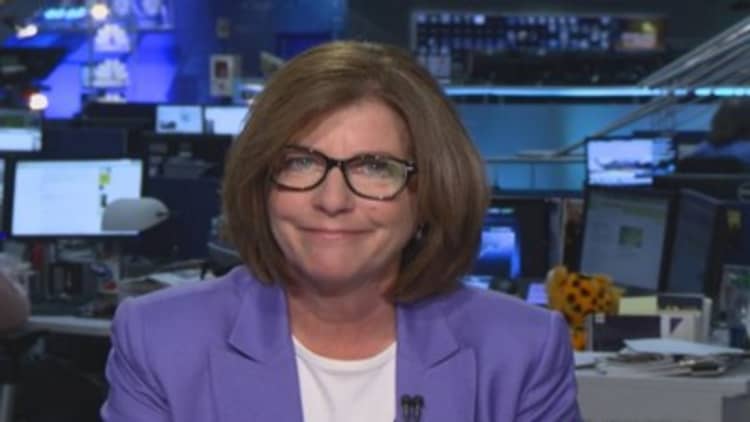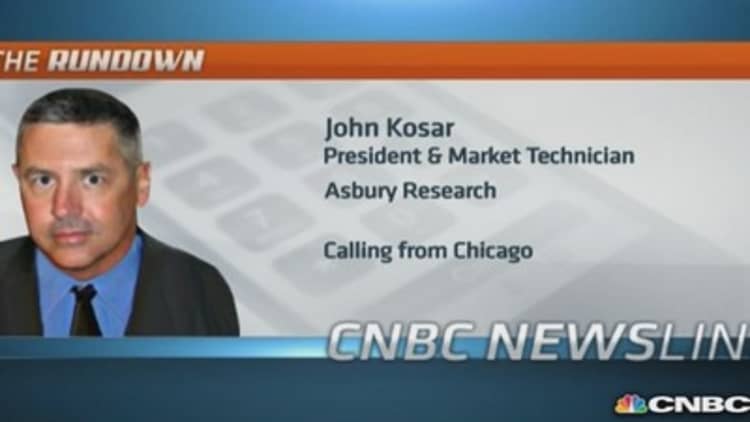
Markets are on high alert for signs the economy is growing enough to support more stock market gains, and the June jobs report could provide some clues not only about the second quarter—but momentum into the second half.
Stock strategists have been fairly optimistic for 2014, and the has risen about 6 percent so far this year. But recent concerns—about both slower growth and rising inflation—have added tensions, as the Fed continues to wind down its quantitative easing program and moves closer to raising rates.
The employment report should be the highlight of the four-day week, and economists expect to see 210,000 nonfarm payrolls and an unchanged unemployment rate of 6.3 percent when the data are released Thursday morning. That would be just slightly lower than last month's 217,000.
The number is especially important after this past week's revisions to first-quarter GDP showed a contraction of 2.9 percent. Economists also slashed their outlooks for the second quarter to an average of 3 percent growth from 3.5 percent after a report of weaker May consumer spending.
But the bigger concern is what happens now in the second half, which was expected to be much more buoyant. Data in the past week did show some improvement, with a rebound in home sales and consumer confidence reported at the highest level since 2008.
"I think obviously with the GDP number being a lot weaker than everyone was expecting, there's a lingering level of concern that this is the start of a slowdown. The unemployment numbers are going to be more critical than ever," said Drew Matus, deputy chief U.S. economist at UBS. "I think there will be some level of comfort if we get the kind of numbers we've been getting."
Car sales are released Tuesday, and they are expected to run at a 16.4 million annualized selling pace, off from May's solid 16.7 million.
"We have to be somewhat optimistic on the outlook. Keep in mind consumers seem to have a big preference for durable goods," Matus said. "Usually when consumers are willing to buy a car, they're willing to buy other things."
Read MoreWinnebago rebound signals strengthening consumer
Matus said he is also watching ISM manufacturing data Tuesday, and manufacturing activity should continue to be strong, as indicated by the Philadelphia Fed and Empire State surveys. He said he expects the data to confirm that second-quarter growth should show good improvement over the first quarter.
As for the second half, he expects growth of just more than 3 percent. "I don't see anything that suggests that's offsides," he said.
Stocks have been drifting higher but hit some rough spots in the past week, when investors worried the Fed's move to normalcy may be coming at a time when the economy is still moving ahead too slowly. Stocks were lower for the week but closed out the month and quarter with solid gains.
"I think the market is looking at this as half full," said BlackRock's chief investment strategist, Russ Koesterich. "If you have a less robust economy, you have a less aggressive Fed ... this is going to be the challenge. If the economy improves, and you have an acceleration in earnings, you can live with a slightly more hawkish Fed."
Read MoreSocial media stocks start to bounce back
The market is vulnerable to a correction, but if there is not a major catalyst—like escalation of the situations in either Ukraine or Iraq—Koesterich says stocks could continue to move higher. His S&P 500 target is 1,950 to 2,000 for year-end.
"I think the stock market is extended, particularly in the U.S. Stocks can grind higher but you have to realize you're starting at a much higher valuation point than you were two years ago," Koesterich said, adding he expects further gains to be fairly muted.
"There's still patches of softness. It's still clear consumption is not booming, but generally the economy is improving. It's a subpar recovery and that hasn't changed," he said.
Koesterich said he will be watching the jobs report for a sign wages are beginning to rise. "There's some anecdotal evidence that you're seeing wage pressures in select areas," but that has not shown up on a national level, he said.
Read MoreWhat babies tell us about housing
"I do think if you see a positive 200,000 (plus) print, people are going to start to be more focused on the first rate hike and that will make some of the hawks on the Fed come out more," he said. The Fed, by its own forecasts, is not expected to start raising rates until 2015.
Some economists have dismissed the pickup in CPI as any meaningful sign of inflation because wages have not grown. But the markets are sensitive to the idea since inflation could push the Fed toward raising rates, while the economy is growing slowly. The yield curve this past week flattened with longer-duration yields falling and shorter-term yields rising. The 10-year yield was at 2.53 percent Friday.
"I think the bond market is adjusting with the flattening of the yield curve. The stock market—I'm not sure what it's thinking," said Peter Boockvar, chief analyst with Lindsey Group.
Read MorePuerto Rico debt slumps on downgrades, new law
Koesterich said he doesn't see a threat from inflation yet. "Six, nine months ago people were worried about real deflation in the U.S., and I think that's abated ... I started to hear some questions about inflation, but it's still early days. When you look at bond yields, there's no inflation baked in," he said. "The stock market is taking comfort, considering how well behaved the bond market has been. It's lot easier to support a multiple of 18 when yields are at 2.5 rather than 3.5 percent."

What to Watch
Monday
9:45 a.m.: Chicago PMI
10:00 a.m.: Pending home sales
10:30 a.m.: Dallas Fed survey
1:10 p.m.: San Francisco Fed President John Williams
Tuesday
Auto sales
10:00 a.m.: ISM manufacturing
10:00 a.m.: Construction spending
Wednesday
8:15 a.m.: ADP employment
10:00 a.m.: Factory orders
11:00 a.m.: Fed Chair Janet Yellen on financial stability in central banking lecture at IMF
Thursday
8:30 a.m.: Weekly jobless claims
8:30 a.m.: Employment report
8:30 a.m.: International trade
10:00 a.m.: ISM nonmanufacturing
Friday
Fourth of July holiday
—By CNBC's Patti Domm.


